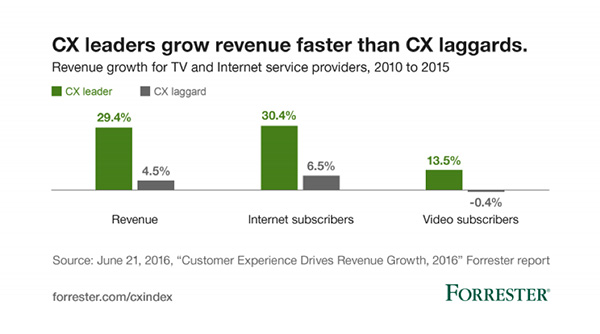Why Is Customer Satisfaction Important?

Last updated on March 1, 2024
You’ve probably never heard a business say that customer satisfaction doesn’t matter. That’s because the importance of customer satisfaction is generally taken for granted, regardless of industry or organization.
In one sense, that’s probably a good thing (at least for customers!). But there’s a problem with simply assuming the importance of customer satisfaction: if you don’t have a solid understanding of why customer satisfaction is important, you risk undervaluing it.
Consider this: when we assume we understand something, we never really stop and think about it. For a business that wants to grow, not thinking strategically about customer satisfaction can be a very risky approach to take.
If you’ve made that mistake, this post will help. We’ll cover what customer satisfaction is and why it’s so important. By the end, you’ll understand the importance of customer satisfaction and be equipped to start improving your organization’s customer experience.
Check out how you can improve and manage your customer experience easily with Lumoa. Sign up for a free trial here.
What is customer satisfaction?
Terms like “customer satisfaction” and “customer experience” get thrown around a lot these days. It’s great that they are far more prevalent than they were a few decades ago, but it can be challenging to get everyone to agree on what they mean. As we’ll be referencing both terms a lot, let’s get clear on what they both mean for the purposes of this post:
-
Customer Satisfaction (CSAT) is a broad term to describe a way of measuring how happy customers are with your service. This is typically done through a few different types of customer surveys, often sent shortly after an interaction with the customer. For example, you might send a CSAT survey shortly after a customer contacts your support team in an attempt to gauge their satisfaction with the support they received.

CSAT is generally transactional. It measures the customer’s satisfaction with a specific interaction. This sets it apart from more relational metrics such as Net Promoter Score (NPS), which aim to measure a customer’s overall experience with your brand or product.
-
Customer Experience (CX) is the overall result of how customers perceive their interactions with your company. It’s challenging to measure, because an “experience” encompasses many different aspects from the speed of service, to agent friendliness, to clarity in online marketing content. Everything the customer sees comes together to create the customer experience. With that being said, a ton of research on improving customer experience has occurred over the last few years, leading to clear and actionable steps you can take to have a positive effect on your organization’s customer experience.
Note: both of these definitions are paraphrases from our A to Z glossary of customer experience terms. Check out the whole thing for a lot more!
Customer satisfaction is a small but important piece of the larger customer experience your organization has created. Without focusing on customer satisfaction, your customer’s overall perception of your brand will suffer.
Five reasons why customer satisfaction is so important
Now that we’re on the same page, let’s look at the importance of customer satisfaction. Why does it matter if your customers are happy with their service?
There is a long list of reasons why you should pay attention to customer satisfaction, but we’ve highlighted five of the most critical reasons below.
1. Retaining customers is way cheaper than acquiring new customers
Acquiring new customers takes a lot of resources. Content creation, inbound and outbound marketing, nurturing leads, closing the deal…it takes time, energy, and a lot of money.
According to Harvard Business Review, acquiring a new customer can be anywhere from five to 25 times more expensive than retaining an existing customer. Those numbers may be shocking, but they make sense. Spending money on a new product or service is always a gamble for prospective customers – they never know for sure if you’re offering is exactly what they need. A satisfied customer trusts your brand and knows what to expect – they are far more likely to return.
Focusing on customer satisfaction and retention isn’t just less expensive. According to Bain & Co, something as small as a 5% increase in customer retention can lead to far greater increases in profits – as much as 25% in some industries!
By gathering insights and taking action to ensure high customer satisfaction with every interaction, you can set yourself up for significant financial growth.
2. Reputations are powerful
When was the last time you purchased something from Amazon without first checking the product reviews? If you’re like most people, it’s been a long time. In fact, 9 out of 10 purchasers include reviews in their purchasing decision.
Delivering a great customer experience can be a huge driver for word-of-mouth advertising and referrals. According to Nielsen, 92% of people trust personal recommendations from their friends and family over any other type of advertising. Why? Because they know that they can trust their loved ones to give them good recommendations.
This is where the importance of customer satisfaction can have an exponential effect on your business. Every time a customer leaves an interaction with your business satisfied, they become more likely to refer other people to your business. Positive experiences stick with people, and the next time they hear someone in need, the satisfying experience they’ve had with your organization is likely to come to mind.
3. It’s a crowded marketplace
It’s highly unlikely that you’re the only business in your industry. Due to the ease of opening a new business online over the last decade, most industries are becoming extremely competitive.
Struggling to stand out in a crowded marketplace? You can do it by delivering an exceptional customer experience.
A few years ago, Walker’s research claimed that by 2020 customer experience would be the key differentiator for businesses. The past few years have shown their prediction to be accurate. Studies show that the vast majority of customers – over 7 out of 10 – report that customer experience is an important factor in their purchasing decisions. On top of that, the research shows that people are often willing to pay more for a better customer experience.
4. Customer satisfaction drives growth
Happy customers mean a growing business, right? While this point might seem self-explanatory, it’s important to have hard data when you’re working to build consensus around investing in improving your customer satisfaction.
Consulting firm McKinsey put it this way: “More broadly, the effect of customer satisfaction on total return to shareholders (TRS) is dramatic…leaders achieve four times the growth in value of the laggards over a ten-year period.”
They aren’t the only ones. In a study conducted by Forrester, they found that customer experience leaders showed higher growth in revenue and in customer counts:

In this day and age, investing in customer satisfaction and customer experience should be a top-level priority from executives to frontline employees.
5. Customer satisfaction improves employee morale
Your support team doesn’t love dealing with angry customers.
It’s exhausting. While every support agent encounters unsatisfied or upset customers at times, dealing with them all day, every day is a major drain. It’s a drain that’s likely to lead to lower employee morale, lower engagement, and higher turnover rates.
This matters for you because disengaged employees have a harder time serving your customers well. Unhappy customers lead to unhappy agents, who then have a harder time creating satisfying customer experiences.
It’s a vicious negative cycle that can be difficult to break out of. But fortunately, the opposite is also true!
There’s a correlation between customer satisfaction and agent satisfaction. It’s difficult to diagnose which comes first – do happy employees result in happy customers, or do happy customers result in happy employees? – but the implication is clear: it’s critical to invest in your customer satisfaction and agent satisfaction.
Doing one without the other is like trying to row with only one oar – you’ll just keep going in circles.
Conclusion
We’ve looked at a few examples that demonstrate the importance of customer satisfaction. As noted above, there are many more!
Hopefully, you can now clearly see the importance of ongoing investment to improve your customer satisfaction and customer experience. If so, we’ve gathered a collection of resources to help you figure out where to begin:
- 6 Most popular customer experience metrics and KPIs explained simply
-
A detailed look at several companies offering phenomenal customer experiences
As you’re exploring these and determining your next steps, remember that you should attack this from two angles: improving customer satisfaction with every interaction with your company and improving overall customer experience and loyalty.
If you’re looking for an easy way to get started, leverage the power of artificial intelligence to uncover opportunities by signing up for a free trial.

